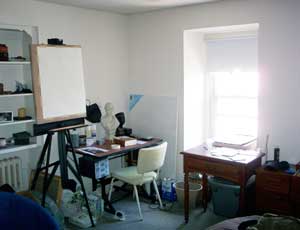Assessing Your Needs
Setting up an in-home art studio need not be a daunting task, nor should you feel like you’ll have to forget about this year’s vacation in order to fund it. In order for it to meet your artistic needs, you will have to decide what you’re going to be doing with your new studio space. Are you envisioning painting large canvases or working from a live model? Do you wish to start small and work mainly from smaller subjects or photographs? Do you want to be able to set up a still-life and work from it over time? These are all important questions to ask yourself before deciding on a space.
The ideal qualities of an art studio are ample floor space, high ceilings (over 7 ft. if possible), large, north-facing windows (allowing for the most consistent natural light all day long), and plenty of ventilation to allow fresh air to pass through. Of course, most of us don’t have the luxury of picking out the perfect space. If you’re like me, you have to work with what you’ve got, which sometimes isn’t very much. No worries – I hope to show you that even a small space, while certainly not the perfect scenario, can still be of great use.
Understanding Your Limitations, and Overcoming Them

I sometimes think of my current art-making space as the “lowest common denominator” in terms of a successful studio. I live in a one-bedroom apartment with my wife and two cats, and my “studio” is the corner of our bedroom (roughly 5 ft. x 6 ft. with a standard 7 ft. ceiling). Regardless of these limitations, I have still managed to come up with a solution to continue working on my skills using traditional methods. All it takes is some creative organizational thinking and a well thought out plan on what kind of work you’re going to be doing. For example, my setup is different for painting than it is for drawing, but doesn’t require too much effort to convert the space.
Making the Most of What You’ve Got
Let me be the first to offer this encouragement: No matter how “non-ideal” your conditions may be, it is safe to say that you can still produce great art, no matter what the circumstances. Don’t let anyone lead you to believe anything different. Your success lies in your commitment level – not the layout of your studio space. Besides, technological innovation has been kind to the art world, in that we have less-toxic and more conumer-friendly art materials available for those that are limited by their surroundings. The first time I opened a small bottle of pure turpentine in my bedroom I immediately realized that I was going to have to find an alternative. Thankfully, petroleum-based odorless mineral spirits were a perfectly acceptable substitute. Precautions still need to be taken when working with any kind of chemicals, but at least I knew that I wasn’t going to die in my sleep the following night!
At the end of the day what is important is that you’ve got a space that meets your basic needs and doesn’t cause disruption in the lives of those who share the space with you. (My wife and I have had several “discussions” about the space-limitations of my studio over the past year…) Living in harmony with those around you is important to being able to stay motivated and focused. If you follow these simple steps I’m sure that you will be able to find a suitable space in which to work comfortably and efficiently.